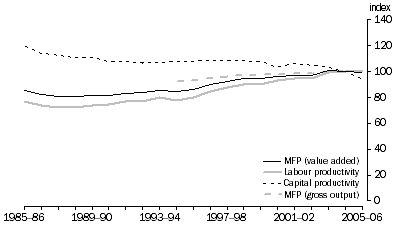PRODUCTIVITY
While there has been growth in productivity in Retail trade it did not enjoy the high growth rates that occurred in some industries over the 1990s, such as Wholesale trade and Communications. However, there have been significant changes in the industry since the late 1980s that affected measured productivity.
Figure 9.1 presents the productivity performance for Retail trade. The chart shows an upward trend in MFP growth on a value added basis. The annual average rate for the period 1985-86 to 2005-06 was relatively low at 0.7% per year. This rate is below the market sector for this period, which grew at 1.2%. The fastest growing period for the Retail trade sector was during the 1990s. Prior to this MFP growth was relatively flat, and since the late 1990s MFP growth has again slowed.
9.1 Retail MFP, labour productivity and capital productivity (2004-05 = 100)

Gross output based MFP estimates are also presented in Figure 9.1. The figure shows that the gross output based MFP grew more slowly than value added based MFP, which is to be expected.
Figure 9.1 also presents labour productivity and capital productivity. Labour productivity has grown more strongly than MFP, but capital productivity has trended down for much of last twenty years.
 Print Page
Print Page
 Print All
Print All
 Print Page
Print Page
 Print All
Print All